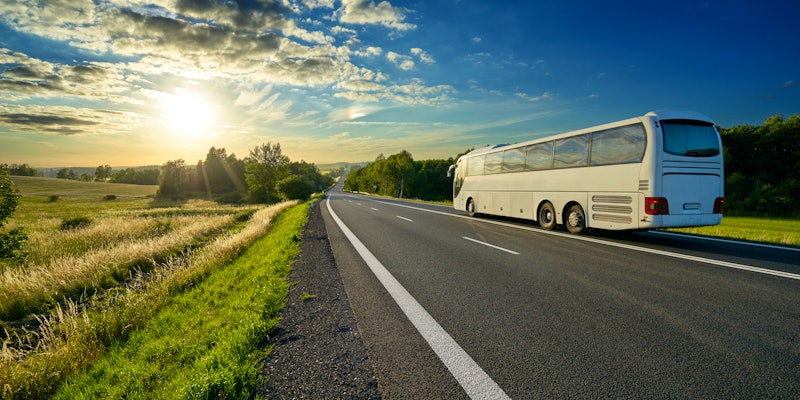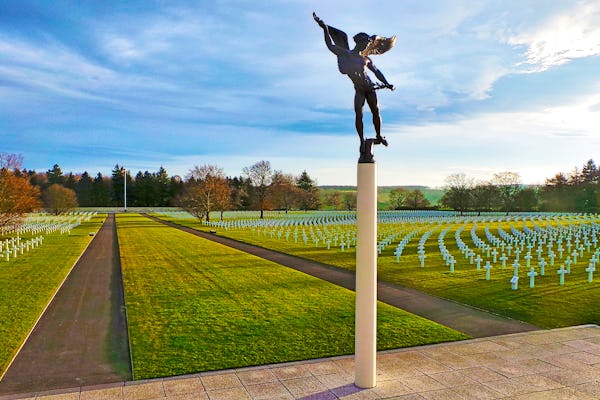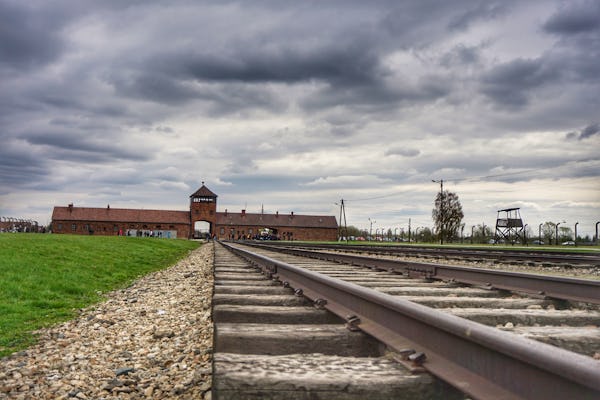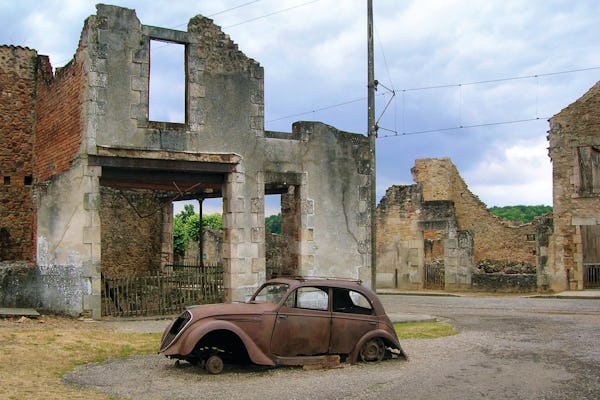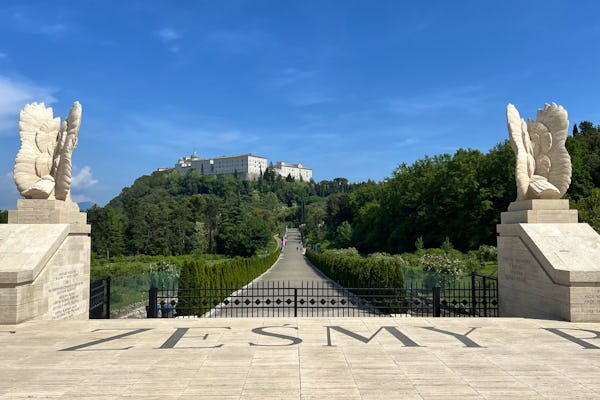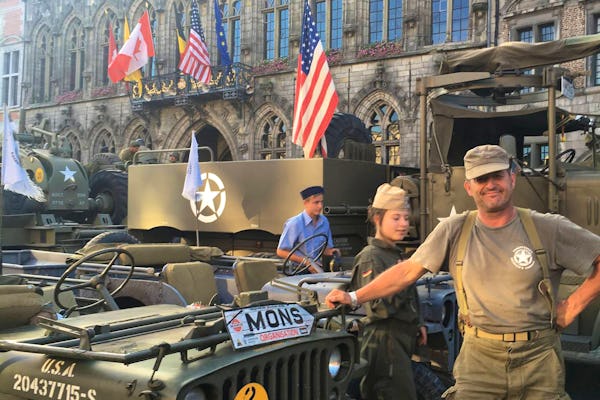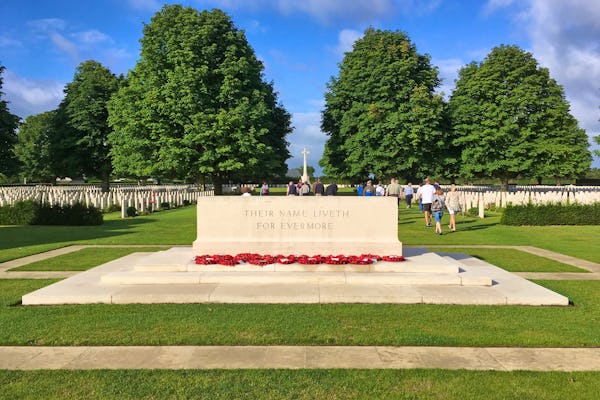Last-Minute Holidays
Look forward to a holiday departing soon!
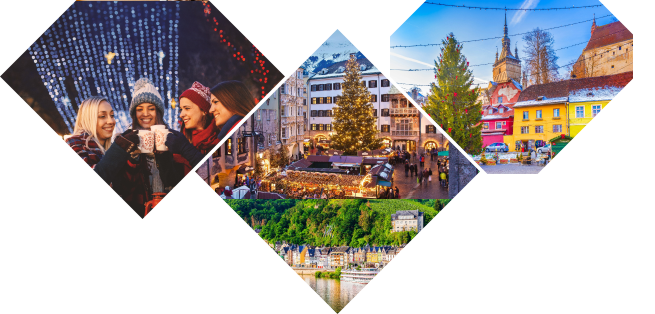
Slip away this Festive season
Battlefield Tours
57 tours from £429pp
Embark on a journey of remembrance and discovery on one of our Leger Battlefield Tours, visiting the WW1 battlefields, WW2 battlefields and sites from other significant wars, including Waterloo and The American Civil War. Each coach or air tour is accompanied by a Specialist Battlefield Guide, whose knowledge and passion will inspire and enhance your experience and truly bring history to life. They will help you to decipher the legacy left behind, and understand the military history that touched us all; whether it relates to Flanders Fields, the Somme battlefields, front line of the Ypres Salient, the sandy beaches of Normandy in France or the concrete walls that once surrounded Berlin.
And, with an ever-expanding range of itineraries, specially selected by our Head Battlefield Guide, Paul Reed, and his team of guides, we aim to ensure you get the most from this memorable experience. So join us as we ‘remember them’, maybe even at the emotive Last Post Ceremony at the Menin Gate, and ensure that the legacy is never forgotten.
Veteran Ken Cooke joins us in Normandy for VE Day
Watch Battlefield Guide Ben Mayne’s interview with veteran Ken Cooke, who landed at Gold Beach as an 18-year-old and later fought his way into Germany, on our special anniversary tour in commemoration of the 80th anniversary of VE Day.
Find your next holiday
Filter Holidays
We have found 57 Coach holidays available from £429pp
D-Day Landings in Normandy
4.6
134 reviews
Join our specialist guides on an awe-inspiring journey learning about the Normandy landings, a turning point in WW2, on this impressive tour.
- 3 or 4 nights hotel with continental breakfast
- Convenient local joining points
Availability:
-
2026
- Jan
- Feb
- Mar
- Apr
- May
- Jun
- Jul
- Aug
- Sep
- Oct
- Nov
- Dec
-
2027
- Jan
- Feb
- Mar
- Apr
- May
- Jun
- Jul
- Aug
- Sep
- Oct
- Nov
- Dec
All Quiet on the Western Front
4.7
109 reviews
Witness the major WW1 battlefields of Flanders and France on this ideal introductory battlefield tour visiting Ypres, The Somme and Menin Gate.
- 3 or 4 nights hotel with continental breakfast
- Specialist Battlefield Guide
- Convenient local joining points
Availability:
-
2026
- Jan
- Feb
- Mar
- Apr
- May
- Jun
- Jul
- Aug
- Sep
- Oct
- Nov
- Dec
-
2027
- Jan
- Feb
- Mar
- Apr
- May
- Jun
- Jul
- Aug
- Sep
- Oct
- Nov
- Dec
Air War Europe: Colditz, Dambusters & the Great Escape
5.0
14 reviews
Join our tour focusing on the air war of WW2, where the RAF Bomber Command took the conflict to the heart of the enemy above Europe.
- 8 nights hotel with continental breakfast
- Specialist Battlefield Guide
- Convenient local joining points
Availability:
-
2026
- Jan
- Feb
- Mar
- Apr
- May
- Jun
- Jul
- Aug
- Sep
- Oct
- Nov
- Dec
-
2027
- Jan
- Feb
- Mar
- Apr
- May
- Jun
- Jul
- Aug
- Sep
- Oct
- Nov
- Dec
Operation Market Garden
4.1
12 reviews
On this tour, we follow the ill-fated Operation Market Garden along their original route as we head to the key areas of the WW2 offensive in Belgium and the Netherlands.
- 3 or 4 nights hotel with continental breakfast
- Specialist Battlefield Guide
- Convenient local joining points
Availability:
-
2026
- Jan
- Feb
- Mar
- Apr
- May
- Jun
- Jul
- Aug
- Sep
- Oct
- Nov
- Dec
-
2027
- Jan
- Feb
- Mar
- Apr
- May
- Jun
- Jul
- Aug
- Sep
- Oct
- Nov
- Dec
Battle of the Bulge
4.8
21 reviews
Travel with us to understand Hitler's last gamble in the West: the Battle of the Bulge. Today, the largest WW2 battlefield in Western Europe.
- 3 or 4 nights hotel with continental breakfast
- Specialist Battlefield Guide
- Convenient local joining points
Availability:
-
2026
- Jan
- Feb
- Mar
- Apr
- May
- Jun
- Jul
- Aug
- Sep
- Oct
- Nov
- Dec
-
2027
- Jan
- Feb
- Mar
- Apr
- May
- Jun
- Jul
- Aug
- Sep
- Oct
- Nov
- Dec
Dunkirk & Fortress Europe
4.6
14 reviews
Join us as we learn about the Retreat to Dunkirk, evacuation from the beaches, and construction of the Atlantic Wall bunkers and V-Weapons.
- 3 or 4 nights hotel with continental breakfast
- Specialist Battlefield Guide
- Convenient local joining points
Availability:
-
2026
- Jan
- Feb
- Mar
- Apr
- May
- Jun
- Jul
- Aug
- Sep
- Oct
- Nov
- Dec
-
2027
- Jan
- Feb
- Mar
- Apr
- May
- Jun
- Jul
- Aug
- Sep
- Oct
- Nov
- Dec
On this ultimate D-Day tour, we cover all five invasion beaches, Airborne sectors and special locations like Pointe du Hoc and Merville Battery.
- 6 nights hotel with continental breakfast
- Specialist Battlefield Guide
- Convenient local joining points
Availability:
-
2026
- Jan
- Feb
- Mar
- Apr
- May
- Jun
- Jul
- Aug
- Sep
- Oct
- Nov
- Dec
-
2027
- Jan
- Feb
- Mar
- Apr
- May
- Jun
- Jul
- Aug
- Sep
- Oct
- Nov
- Dec
Travel with us to Ypres, the main British battlefield of the First World War, and stay right in the heart of the city, close to the Menin Gate.
- 3 or 4 nights hotel with continental breakfast
- Specialist Battlefield Guide
- Convenient local joining points
Availability:
-
2026
- Jan
- Feb
- Mar
- Apr
- May
- Jun
- Jul
- Aug
- Sep
- Oct
- Nov
- Dec
-
2027
- Jan
- Feb
- Mar
- Apr
- May
- Jun
- Jul
- Aug
- Sep
- Oct
- Nov
- Dec
Follow the iconic actions of British Commandos including heroic battles like Operations Jubilee and Chariot, as well as D-Day.
- 6 nights hotel with continental breakfast
- Specialist Battlefield Guide
- Convenient local joining points
Availability:
-
2026
- Jan
- Feb
- Mar
- Apr
- May
- Jun
- Jul
- Aug
- Sep
- Oct
- Nov
- Dec
-
2027
- Jan
- Feb
- Mar
- Apr
- May
- Jun
- Jul
- Aug
- Sep
- Oct
- Nov
- Dec
On this fascinating tour in Normandy, delve into the real story of the Easy Company and celebrate 25 years of the 'Band of Brothers' mini-series.
- 4 or 6 nights hotel with continental breakfast
- Specialist Battlefield Guide
- Local joining points
Availability:
-
2026
- Jan
- Feb
- Mar
- Apr
- May
- Jun
- Jul
- Aug
- Sep
- Oct
- Nov
- Dec
Reims & Verdun
5.0
3 reviews
Take a look at the ground fought over by the British, French and German Armies in Reims, combining with a visit to Verdun – an iconic WW1 site.
- 4 nights hotel with continental breakfast
- Specialist Battlefield Guide
- Convenient local joining points
Availability:
-
2026
- Jan
- Feb
- Mar
- Apr
- May
- Jun
- Jul
- Aug
- Sep
- Oct
- Nov
- Dec
-
2027
- Jan
- Feb
- Mar
- Apr
- May
- Jun
- Jul
- Aug
- Sep
- Oct
- Nov
- Dec
Take an in-depth look at the Holocaust, one of the darkest aspects of WW2, as we visit Auschwitz and Kraków on this emotive tour.
- 4 nights hotel with continental breakfast
- Specialist Historical Guide
- Return flights to Kraków with hand luggage allowance
- Airport transfers in Poland
- Air-conditioned coach travel
Availability:
-
2026
- Jan
- Feb
- Mar
- Apr
- May
- Jun
- Jul
- Aug
- Sep
- Oct
- Nov
- Dec
-
2027
- Jan
- Feb
- Mar
- Apr
- May
- Jun
- Jul
- Aug
- Sep
- Oct
- Nov
- Dec
One of the darkest chapters of the 20th century, join us on a journey of Remembrance as we look into heart-wrenching stories of the Holocaust.
- 11 nights hotel with continental breakfast
- Specialist Historical Guide
- Convenient local joining points
Availability:
-
2026
- Jan
- Feb
- Mar
- Apr
- May
- Jun
- Jul
- Aug
- Sep
- Oct
- Nov
- Dec
-
2027
- Jan
- Feb
- Mar
- Apr
- May
- Jun
- Jul
- Aug
- Sep
- Oct
- Nov
- Dec
The Somme Offensive
4.6
21 reviews
This fascinating tour takes an in-depth look at both familiar and lesser-known battlefield locations, covering aspects of 'the forgotten Somme'.
- 4 nights hotel with continental breakfast
- 1 lunch at Ulster Tower
- 1 dinner at Le Tommy
- 2 evening meals (5-day tour only)
- Specialist Battlefield Guide
- Convenient local joining points
Availability:
-
2026
- Jan
- Feb
- Mar
- Apr
- May
- Jun
- Jul
- Aug
- Sep
- Oct
- Nov
- Dec
-
2027
- Jan
- Feb
- Mar
- Apr
- May
- Jun
- Jul
- Aug
- Sep
- Oct
- Nov
- Dec
Wartime Paris: Spies, Resistance and the Holocaust
4.2
6 reviews
Joined by Paul Reed and Dr Victoria Humphreys, uncover the details of the Special Operations Executive in France on this new tour.
- 3 nights hotel with continental breakfast
- Two Specialist Battlefield Guides
- Convenient local joining points
Availability:
-
2026
- Jan
- Feb
- Mar
- Apr
- May
- Jun
- Jul
- Aug
- Sep
- Oct
- Nov
- Dec
-
2027
- Jan
- Feb
- Mar
- Apr
- May
- Jun
- Jul
- Aug
- Sep
- Oct
- Nov
- Dec
This tour examines key sites from the Rise and Fall of the Third Reich, including Munich, Berlin, and the incredible Eagle’s Nest in Germany.
- 11 nights hotel with continental breakfast
- Specialist Historical Guide
- Convenient local joining points
Availability:
-
2026
- Jan
- Feb
- Mar
- Apr
- May
- Jun
- Jul
- Aug
- Sep
- Oct
- Nov
- Dec
-
2027
- Jan
- Feb
- Mar
- Apr
- May
- Jun
- Jul
- Aug
- Sep
- Oct
- Nov
- Dec
Join us on a fascinating tour as we explore the WW2 battlefields in Poland, the Warsaw Uprising and some of the most important Holocaust sites.
- 11 nights hotel with continental breakfast
- Specialist Battlefield Guide
- Convenient local joining points
Availability:
-
2026
- Jan
- Feb
- Mar
- Apr
- May
- Jun
- Jul
- Aug
- Sep
- Oct
- Nov
- Dec
-
2027
- Jan
- Feb
- Mar
- Apr
- May
- Jun
- Jul
- Aug
- Sep
- Oct
- Nov
- Dec
Join us on a solo travellers' tour to the Battle of the Bulge battlefields in the Belgian Ardennes, seeing tanks, memorials, foxholes and more.
- No single supplement and sole use of your own room
- 4 nights hotel with continental breakfast
- 3 evening meals
- Local joining points
Availability:
-
2026
- Jan
- Feb
- Mar
- Apr
- May
- Jun
- Jul
- Aug
- Sep
- Oct
- Nov
- Dec
-
2027
- Jan
- Feb
- Mar
- Apr
- May
- Jun
- Jul
- Aug
- Sep
- Oct
- Nov
- Dec
Join us on a special tour to commemorate the Menin Gate centenary and visit some key battlefield sites in Flanders.
- 3 nights hotel with continental breakfast
- Specialist Battlefield Guide
- Local joining points
Availability:
-
2027
- Jan
- Feb
- Mar
- Apr
- May
- Jun
- Jul
- Aug
- Sep
- Oct
- Nov
- Dec
Beer & Battlefields in the Ardennes
4.4
9 reviews
A new beer and battlefields tour looking at WW2 in the Ardennes, as well as visiting local breweries and the Leffe Experience!
- 4 nights hotel with continental breakfast
- Specialist Battlefield Guide
- Convenient local joining points
- Travel by Silver Service coach
Availability:
-
2026
- Jan
- Feb
- Mar
- Apr
- May
- Jun
- Jul
- Aug
- Sep
- Oct
- Nov
- Dec
-
2027
- Jan
- Feb
- Mar
- Apr
- May
- Jun
- Jul
- Aug
- Sep
- Oct
- Nov
- Dec
Discover the key fortifications along the historic Maginot Line stretching from the Ardennes to the Vosges, built to protect France from invasion.
- 6 nights hotel with continental breakfast
- 3 evening meals
- 1 special meal from the Alsace region
- A Folklore evening
- Specialist Battlefield Guide
- Local joining points
Availability:
-
2026
- Jan
- Feb
- Mar
- Apr
- May
- Jun
- Jul
- Aug
- Sep
- Oct
- Nov
- Dec
-
2027
- Jan
- Feb
- Mar
- Apr
- May
- Jun
- Jul
- Aug
- Sep
- Oct
- Nov
- Dec
Discover the wartime history of France from defeat in 1940, to Occupation and Resistance, as well as the dark chapters of the Holocaust.
- 6 nights hotel with continental breakfast
- Specialist Battlefield Guide
- Convenient local joining points
Availability:
-
2026
- Jan
- Feb
- Mar
- Apr
- May
- Jun
- Jul
- Aug
- Sep
- Oct
- Nov
- Dec
-
2027
- Jan
- Feb
- Mar
- Apr
- May
- Jun
- Jul
- Aug
- Sep
- Oct
- Nov
- Dec
Forgotten Battlefields of WW1
4.9
8 reviews
This tour takes us off the beaten track as we discover the forgotten battlefields of WW1, covering the 1915 battles, Arras and Cambrai in 1917.
- 4 nights hotel with continental breakfast
- Specialist Battlefield Guide
- Convenient local joining points
Availability:
-
2026
- Jan
- Feb
- Mar
- Apr
- May
- Jun
- Jul
- Aug
- Sep
- Oct
- Nov
- Dec
-
2027
- Jan
- Feb
- Mar
- Apr
- May
- Jun
- Jul
- Aug
- Sep
- Oct
- Nov
- Dec
The U-Boat War: The Real Das Boot
4.8
5 reviews
Take an in-depth look at WW2’s Das Boot as we head to Germany to look at the story of the U-Boats, visiting Wilhelmshaven, Kiel and Bremen.
- 6 nights hotel with continental breakfast
- Specialist Battlefield Guide
- Convenient local joining points
Availability:
-
2026
- Jan
- Feb
- Mar
- Apr
- May
- Jun
- Jul
- Aug
- Sep
- Oct
- Nov
- Dec
-
2027
- Jan
- Feb
- Mar
- Apr
- May
- Jun
- Jul
- Aug
- Sep
- Oct
- Nov
- Dec
A great introductory battlefield tour looking at major battle sites across Belgium, from the Battle of Waterloo to its liberation in 1944.
- 4 nights hotel with continental breakfast
- Specialist Battlefield Guide
- Convenient local joining points
Availability:
-
2026
- Jan
- Feb
- Mar
- Apr
- May
- Jun
- Jul
- Aug
- Sep
- Oct
- Nov
- Dec
-
2027
- Jan
- Feb
- Mar
- Apr
- May
- Jun
- Jul
- Aug
- Sep
- Oct
- Nov
- Dec
Take an in-depth look at the Italian Campaign, visiting the key battlefield sites of Anzio, Monte Cassino and San Pietro on this WW2 tour.
- Return flights to Rome with hand luggage allowance
- Airport transfers in Italy
- 4 nights hotel with continental breakfast
- Specialist Battlefield Guide
Availability:
-
2026
- Jan
- Feb
- Mar
- Apr
- May
- Jun
- Jul
- Aug
- Sep
- Oct
- Nov
- Dec
-
2027
- Jan
- Feb
- Mar
- Apr
- May
- Jun
- Jul
- Aug
- Sep
- Oct
- Nov
- Dec
All Quiet on the Western Front for Solo Travellers
4.8
6 reviews
We visit the key sites of Ypres, The Somme, Arras and the Vimy Ridge on this introductory tour of WW1 on the Western Front in Belgium and France.
- No single supplement and sole use of your own room
- 4 nights hotel with continental breakfast
- Specialist Battlefield Guide
- Travel by Luxuria coach
Availability:
-
2026
- Jan
- Feb
- Mar
- Apr
- May
- Jun
- Jul
- Aug
- Sep
- Oct
- Nov
- Dec
-
2027
- Jan
- Feb
- Mar
- Apr
- May
- Jun
- Jul
- Aug
- Sep
- Oct
- Nov
- Dec
In a new version of this popular tour, we travel to Spain and follow the battles and engagements of the army of Sir Arthur Wellesley, Lord Wellington, in the Peninsular War, battles popularised in the Bernard Cornwall’s ‘Sharpe’ novels.
- 10 nights hotel accommodation with continental breakfast and 8 evening meals
- Overnight ferry crossing with Brittany Ferries from Plymouth to Santander in an en suite inside cabin (meals at extra cost).
- Convenient local joining points
Availability:
-
2026
- Jan
- Feb
- Mar
- Apr
- May
- Jun
- Jul
- Aug
- Sep
- Oct
- Nov
- Dec
-
2027
- Jan
- Feb
- Mar
- Apr
- May
- Jun
- Jul
- Aug
- Sep
- Oct
- Nov
- Dec
Join us on this UK-based tour where we explore the significant sites connected to the preparations for the D-Day Landings in 1944.
- 4 nights hotel with English breakfast
- A farewell dinner
- Specialist Battlefield Guide
- Local joining points
Availability:
-
2026
- Jan
- Feb
- Mar
- Apr
- May
- Jun
- Jul
- Aug
- Sep
- Oct
- Nov
- Dec
Visit significant locations to get an understanding of what medics, padres, nurses and soldiers did outside of the trenches during World War 1.
- 4 nights hotel with continental breakfast
- Specialist Battlefield Guide
- Convenient local joining points
Availability:
-
2027
- Jan
- Feb
- Mar
- Apr
- May
- Jun
- Jul
- Aug
- Sep
- Oct
- Nov
- Dec
Join this fascinating tour of the Battle of Waterloo to attend the anniversary of the battle.
- 3 nights hotel with continental breakfast
- Specialist Historical Guide
- Convenient local joining points
Availability:
-
2026
- Jan
- Feb
- Mar
- Apr
- May
- Jun
- Jul
- Aug
- Sep
- Oct
- Nov
- Dec
-
2027
- Jan
- Feb
- Mar
- Apr
- May
- Jun
- Jul
- Aug
- Sep
- Oct
- Nov
- Dec
Walking the Somme Battlefields
4.6
7 reviews
Walk with us along the lanes of the Somme Battlefields as we look in depth at this iconic battle of WW1, seeing Bois Francais, Pals Memorial and more.
- 4 nights hotel with continental breakfast
- Specialist Battlefield Guide
- Convenient local joining points
Availability:
-
2026
- Jan
- Feb
- Mar
- Apr
- May
- Jun
- Jul
- Aug
- Sep
- Oct
- Nov
- Dec
-
2027
- Jan
- Feb
- Mar
- Apr
- May
- Jun
- Jul
- Aug
- Sep
- Oct
- Nov
- Dec
Amiens stood at the centre of so many important battles in WW1. Join us as we look at the fighting here during all four years of the conflict.
- 4 nights hotel with continental breakfast
- Specialist Battlefield Guide
- Convenient local joining points
Availability:
-
2026
- Jan
- Feb
- Mar
- Apr
- May
- Jun
- Jul
- Aug
- Sep
- Oct
- Nov
- Dec
-
2027
- Jan
- Feb
- Mar
- Apr
- May
- Jun
- Jul
- Aug
- Sep
- Oct
- Nov
- Dec
Join us on a battlefield tour looking at the key battles on the German Hindenburg Line defences during the final years of the Great War.
- 4 nights hotel with continental breakfast
- 1 dinner at Le Tommy
- 2 evening meals
- Specialist Battlefield Guide
- Convenient local joining points
Availability:
-
2026
- Jan
- Feb
- Mar
- Apr
- May
- Jun
- Jul
- Aug
- Sep
- Oct
- Nov
- Dec
-
2027
- Jan
- Feb
- Mar
- Apr
- May
- Jun
- Jul
- Aug
- Sep
- Oct
- Nov
- Dec
Travel with us to the haunting Somme Battlefields to attend the 110th Anniversary of the start of the battle in 1916.
- 4 nights hotel with continental breakfast
- Specialist Battlefield Guide
- Convenient local joining points
Availability:
-
2026
- Jan
- Feb
- Mar
- Apr
- May
- Jun
- Jul
- Aug
- Sep
- Oct
- Nov
- Dec
Discover more about Operation Market Garden, A Bridge Too Far, and the fighting in the Rhineland which followed.
- 2 nights overnight ferry in an inside low berth cabin
- 2 nights hotel with continental breakfast
- Extensive buffet breakfast and buffet dinner on board the overnight ferries
- Specialist Battlefield Guide
- Regional joining points
- Porterage at the hotel
Availability:
-
2026
- Jan
- Feb
- Mar
- Apr
- May
- Jun
- Jul
- Aug
- Sep
- Oct
- Nov
- Dec
On this tour we walk the Ypres battlefields of World War 1, visiting the sites of the Ypres Salient and discussing the fighting that happened here in 1917.
- 4 nights hotel with continental breakfast
- Specialist Battlefield Guide
- Convenient local joining points
Availability:
-
2026
- Jan
- Feb
- Mar
- Apr
- May
- Jun
- Jul
- Aug
- Sep
- Oct
- Nov
- Dec
-
2027
- Jan
- Feb
- Mar
- Apr
- May
- Jun
- Jul
- Aug
- Sep
- Oct
- Nov
- Dec
Join us on a tour of the Italian Battlefields and take a look at some of the most iconic battles such as the landings at Anzio and the fighting for Monte Cassino.
- 11 nights hotel with continental breakfast
- 9 evening meals
- Specialist Battlefield Guide
- Convenient local joining points
Availability:
-
2026
- Jan
- Feb
- Mar
- Apr
- May
- Jun
- Jul
- Aug
- Sep
- Oct
- Nov
- Dec
-
2027
- Jan
- Feb
- Mar
- Apr
- May
- Jun
- Jul
- Aug
- Sep
- Oct
- Nov
- Dec
Join us as we commemorate Armistice Day in Ypres. See the Menin Gate, Tyne Cot and Langemarck German Cemetery on this battlefield tour in Flanders Fields.
- 3 nights hotel with continental breakfast
- Specialist Battlefield Guide
- Convenient local joining points
Availability:
-
2026
- Jan
- Feb
- Mar
- Apr
- May
- Jun
- Jul
- Aug
- Sep
- Oct
- Nov
- Dec
-
2027
- Jan
- Feb
- Mar
- Apr
- May
- Jun
- Jul
- Aug
- Sep
- Oct
- Nov
- Dec
Join us for the annual Tanks in Town event in Mons to commemorate the liberation of the city in 1944.
- 3 nights hotel with continental breakfast
- Specialist Battlefield Guide
- Local joining points
Availability:
-
2026
- Jan
- Feb
- Mar
- Apr
- May
- Jun
- Jul
- Aug
- Sep
- Oct
- Nov
- Dec
-
2027
- Jan
- Feb
- Mar
- Apr
- May
- Jun
- Jul
- Aug
- Sep
- Oct
- Nov
- Dec
Travel with us to Normandy for the annual commemoration of D-Day with ceremonies at either Bayeux or the British Normandy Memorial.
- 3 nights hotel with continental breakfast
- Specialist Battlefield Guide
- Local joining points
Availability:
-
2026
- Jan
- Feb
- Mar
- Apr
- May
- Jun
- Jul
- Aug
- Sep
- Oct
- Nov
- Dec
-
2027
- Jan
- Feb
- Mar
- Apr
- May
- Jun
- Jul
- Aug
- Sep
- Oct
- Nov
- Dec
Gallipoli Battlefields by Air
4.0
2 reviews
Visit the haunting Gallipoli battlefields of 1915, located in Turkey, and visit key WW1 sites and memorials on this in-depth tour.
- 6 nights hotel with continental breakfast
- 5 evening meals
- Specialist Battlefield Guide
- Return flights from Heathrow to Istanbul with one checked-in suitcase
- Airport transfers in Istanbul
- Air-conditioned coach travel
Availability:
-
2026
- Jan
- Feb
- Mar
- Apr
- May
- Jun
- Jul
- Aug
- Sep
- Oct
- Nov
- Dec
-
2027
- Jan
- Feb
- Mar
- Apr
- May
- Jun
- Jul
- Aug
- Sep
- Oct
- Nov
- Dec
Walking the Waterloo Battlefields
4.7
3 reviews
Explore the historic battlefields of Waterloo, learning about the end of the Napoleonic Wars on one of our most popular walking tours in Belgium.
- 4 nights hotel with continental breakfast
- Specialist Battlefield Guide
- Convenient local joining points
Availability:
-
2026
- Jan
- Feb
- Mar
- Apr
- May
- Jun
- Jul
- Aug
- Sep
- Oct
- Nov
- Dec
-
2027
- Jan
- Feb
- Mar
- Apr
- May
- Jun
- Jul
- Aug
- Sep
- Oct
- Nov
- Dec
The year 1914 marked the outbreak of the First World War, travel with us to some of the forgotten battlefields in Belgium from the opening months of this mighty conflict.
- 4 nights hotel with continental breakfast
- 2 evening meals
- Specialist Battlefield Guide
- Convenient local joining points
Availability:
-
2026
- Jan
- Feb
- Mar
- Apr
- May
- Jun
- Jul
- Aug
- Sep
- Oct
- Nov
- Dec
-
2027
- Jan
- Feb
- Mar
- Apr
- May
- Jun
- Jul
- Aug
- Sep
- Oct
- Nov
- Dec
We look at some of the forgotten battlefields of 1945, visit British war cemeteries in Western Germany, and discuss the horrors of the Holocaust.
- 6 nights hotel with continental breakfast
- Specialist Battlefield Guide
- Convenient local joining points
Availability:
-
2026
- Jan
- Feb
- Mar
- Apr
- May
- Jun
- Jul
- Aug
- Sep
- Oct
- Nov
- Dec
-
2027
- Jan
- Feb
- Mar
- Apr
- May
- Jun
- Jul
- Aug
- Sep
- Oct
- Nov
- Dec
Explore the secret history behind occupied northern France in WW2 as we look at the Resistance and the Holocaust from our base in Arras.
- 3 nights hotel with continental breakfast
- Specialist Battlefield Guide
- Convenient local joining points
Availability:
-
2026
- Jan
- Feb
- Mar
- Apr
- May
- Jun
- Jul
- Aug
- Sep
- Oct
- Nov
- Dec
-
2027
- Jan
- Feb
- Mar
- Apr
- May
- Jun
- Jul
- Aug
- Sep
- Oct
- Nov
- Dec
Walking the D-Day Beaches of Normandy
4.8
4 reviews
Walk with us on the Normandy D-Day beaches of WW2, seeing Sword Beach, the Omaha Beach defences and discover the British Airborne story.
- 4 nights hotel with continental breakfast
- Specialist Battlefield Guide
- Convenient local joining points
Availability:
-
2026
- Jan
- Feb
- Mar
- Apr
- May
- Jun
- Jul
- Aug
- Sep
- Oct
- Nov
- Dec
Panzers in Normandy
5.0
3 reviews
Examine the use of Allied tanks and German Panzers on this unique Normandy tour, where you’ll see examples of wartime tanks on the battlefields.
- 4 nights hotel with continental breakfast
- Specialist Battlefield Guide
- Local joining points
Availability:
-
2026
- Jan
- Feb
- Mar
- Apr
- May
- Jun
- Jul
- Aug
- Sep
- Oct
- Nov
- Dec
-
2027
- Jan
- Feb
- Mar
- Apr
- May
- Jun
- Jul
- Aug
- Sep
- Oct
- Nov
- Dec
Peenemünde, the Baltic Coast & Wartime Berlin
4.5
2 reviews
Join us on a fascinating insight into Nazi Germany's 'secret weapons' of WW2, seeing where they were developed and first launched.
- 8 nights hotel with continental breakfast
- Specialist Battlefield Guide
- Convenient local joining points
Availability:
-
2026
- Jan
- Feb
- Mar
- Apr
- May
- Jun
- Jul
- Aug
- Sep
- Oct
- Nov
- Dec
-
2027
- Jan
- Feb
- Mar
- Apr
- May
- Jun
- Jul
- Aug
- Sep
- Oct
- Nov
- Dec
Combine a tour of the Battlefields of the Great War, with time at some of France's fantastic Christmas markets.
- 4 nights hotel with continental breakfast
- Specialist Battlefield Guide
- Convenient local joining points
Availability:
-
2026
- Jan
- Feb
- Mar
- Apr
- May
- Jun
- Jul
- Aug
- Sep
- Oct
- Nov
- Dec
Learn more about the bloody battles for the hedgerows of Normandy as we follow the GIs and paratroopers from the first shots to the breakout.
- 4 nights hotel with continental breakfast
- Specialist Battlefields Guide
- Convenient local joining points
Availability:
-
2026
- Jan
- Feb
- Mar
- Apr
- May
- Jun
- Jul
- Aug
- Sep
- Oct
- Nov
- Dec
-
2027
- Jan
- Feb
- Mar
- Apr
- May
- Jun
- Jul
- Aug
- Sep
- Oct
- Nov
- Dec
Understand more about the Allied breaking of the Siegfried Line in Sept. 1944 and the German Offensive in the Ardennes, the Battle of the Bulge.
- 2 nights overnight ferry in a low-berth inside cabin
- Extensive buffet breakfast and buffet dinner on board the overnight ferries
- 2 nights hotel with continental breakfast
- 1 lunch
- Specialist Battlefield Guide
- Regional joining points
- Porterage at the hotel
Availability:
-
2026
- Jan
- Feb
- Mar
- Apr
- May
- Jun
- Jul
- Aug
- Sep
- Oct
- Nov
- Dec
Combine visits to Christmas Markets in Germany and the Netherlands alongside battlefield sites from the 1944/45 period.
- 4 nights hotel with continental breakfast
- Specialist Battlefield Guide
- Travel by Executive Coach
- Convenient local joining points
Availability:
-
2025
- Jan
- Feb
- Mar
- Apr
- May
- Jun
- Jul
- Aug
- Sep
- Oct
- Nov
- Dec
-
2026
- Jan
- Feb
- Mar
- Apr
- May
- Jun
- Jul
- Aug
- Sep
- Oct
- Nov
- Dec
Join us as we travel the Western Front to the often forgotten ‘end of the line’, where the trenches ran beyond Verdun to the Vosges mountains.
- 6 nights hotel with continental breakfast
- 4 evening meals
- x 1 Special Alsace menu
- Specialist Battlefield Guide
- Convenient local joining points
Availability:
-
2026
- Jan
- Feb
- Mar
- Apr
- May
- Jun
- Jul
- Aug
- Sep
- Oct
- Nov
- Dec
-
2027
- Jan
- Feb
- Mar
- Apr
- May
- Jun
- Jul
- Aug
- Sep
- Oct
- Nov
- Dec
Join us as we follow British and Commonwealth forces in WW2, in the journey they took liberating Normandy, Belgium, and the Netherlands.
- 6 nights hotel with continental breakfast
- Specialist Battlefield Guide
- Battlefield visits as described
- Convenient local joining points
Availability:
-
2026
- Jan
- Feb
- Mar
- Apr
- May
- Jun
- Jul
- Aug
- Sep
- Oct
- Nov
- Dec
-
2027
- Jan
- Feb
- Mar
- Apr
- May
- Jun
- Jul
- Aug
- Sep
- Oct
- Nov
- Dec
This WW2 tour looks at the fighting in the Belgian Ardennes from the tank engagements of the German Blitzkrieg to the Battle of the Bulge.
- 4 nights hotel with continental breakfast
- Local joining points
Availability:
-
2026
- Jan
- Feb
- Mar
- Apr
- May
- Jun
- Jul
- Aug
- Sep
- Oct
- Nov
- Dec
-
2027
- Jan
- Feb
- Mar
- Apr
- May
- Jun
- Jul
- Aug
- Sep
- Oct
- Nov
- Dec
Join us on the perfect introductory tour to the Battlefields of the First World War, visiting key locations at Arras, the Somme and Ypres.
- 2 nights overnight ferry in an low-berth inside cabin
- Extensive buffet breakfast and buffet dinner on board the overnight ferries
- 2 nights hotel with continental breakfast
- 1 lunch
- Specialist Battlefield Guide
- Regional joining points
- Porterage at the hotel
Availability:
-
2026
- Jan
- Feb
- Mar
- Apr
- May
- Jun
- Jul
- Aug
- Sep
- Oct
- Nov
- Dec







